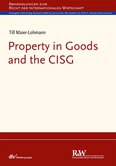V. Suitability of the exclusion under Article 4, sentence 2(b) of the CISG
529
Considering the heavy chains that link national sales (contract) laws to their respective property laws, it may appear regrettable that the CISG has only unified one part of the equation and has left property to national law.
530
Yet, if one agrees with the interpretation of the CISG proposed in the third and fourth chapter above,1102 neither the obligation to transfer the property under Article 30 nor the characterization of a sales contract under the CISG remain interwoven with property law. Furthermore, the transfer of risk representing a field of sales law that is considered dependent on the transfer of property under many national laws, has been completely detached under the CISG.1103 Moreover, the obligation to preserve the goods that is connected to the property in the goods under some national laws is also exhaustively
531
Hence, the exact point in time and the requirements for the transfer of property have no relevance under the CISG. This progressive drafting renders the exclusion of the effect the contract has on the seller’s and third party rights a suitable rule.1107 As a matter of fact, it would have even been regrettable if rules on the transfer of property had been incorporated into the CISG during its drafting: The considerations and effects of these rules would lie outside of the CISG, and therefore, should only be drafted within a uniform law project that touches on matters where the variations of the transfer of property under national law cause practical problems and divergences.
| 1102 | See above paras. 74 et seq. (third chapter) and paras. 281 et seq. (fourth chapter). |
| 1103 | Schlechtriem/Schwenzer/Schroeter/Hachem, Introduction to Arts. 66–70 para. 18; Torsello, International Business Law Journal (2000), 939, 944. See on Res perit domino and references to national laws containing the principle, Schlechtriem/Schwenzer/Schroeter/Hachem, Introduction to Arts. 66–70 para. 8. |
| 1104 | Schlechtriem/Schwenzer/Schroeter/Bacher, Introduction to Arts. 85–88 para. 2. |
| 1105 | See above paras. 342 et seq. |
| 1106 | See above paras. 348 et seq. on the historical development. |
| 1107 | Similarly, Torsello, International Business Law Journal (2000), 939, 947. Less positive assessment, Sauer, 118 ZVglRWiss (2019), 81, 115; Bucher, ZEuP 1998, 615, 617; Ferrari, ZEuP 1993, 52, 78. |


